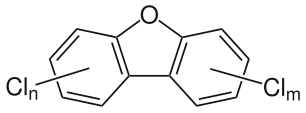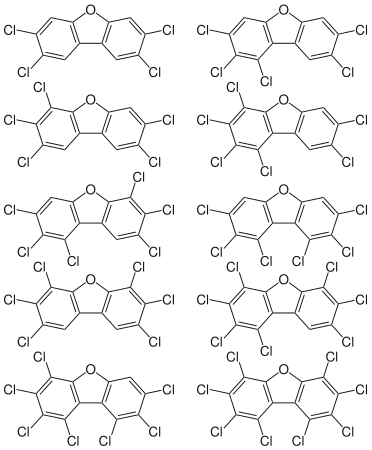Polychlorinated dibenzofurans
More thorough treatise of all groups with similar actions and binding to aryl hydrocarbon reeceptor is given in Dioxins and dioxin-like compounds.


Polychlorinated dibenzofurans (PCDFs) are a family of organic compounds with one or several of the hydrogens in the dibenzofuran structure replaced by chlorines. For example, 2,3,7,8-tetrachlorodibenzofuran (TCDF) has chlorine atoms substituted for each of the hydrogens on the number 2, 3, 7, and 8 carbons (see structure in the upper left corner of the second image). Polychlorinated dibenzofurans with chlorines at least in positions 2,3,7 and 8 are much more toxic than the parent compound dibenzofurane, with properties and chemical structures similar to polychlorinated dibenzodioxins. These groups together are often inaccurately called dioxins. They are known developmental toxicants, and suspected human carcinogens. PCDFs tend to co-occur with polychlorinated dibenzodioxins (PCDDs). PCDFs can be formed by pyrolysis or incineration at temperatures below 1200 °C of chlorine containing products, such as PVC, PCBs, and other organochlorides, or of non-chlorine containing products in the presence of chlorine donors.[1] Dibenzofurans are known persistent organic pollutants (POP), classified among the dirty dozen in the Stockholm Convention on Persistent Organic Pollutants.
Safety, toxicity, regulation
Occupational exposure to PCDFs may occur through inhalation and contact with the skin, although intake even in workers at waste incineration plants are not particularly high.[2][3] For general population the most important source is food of animal origin like with other dioxin-like compounds.[4][5][6] The most relevant congener is 2,3,4,7,8-pentachlorodibenzofuran (2,3,4,7,8-PCDF) which is more toxic and based on relative toxicity more prevalent than other PCDFs.[4]
References
- "Proceedings of the Subregional Awareness Raising Workshop on Persistent Organic Pollutants (POPs), Bangkok, Thailand". United Nations Environment Programme. November 25–28, 1997. Archived from the original on 2007-08-08. Retrieved 2007-12-11.
- U.S. Department of Health and Human Services. Hazardous Substances Data Bank (HSDB, online database).
- Kumagai S, Koda S, Miyakita T, Ueno M (2002) Polychlorinated dibenzo-p-dioxin and dibenzofuran concentrations in serum samples of workers at intermittently burning municipal waste incinerators in Japan. Occupational and Environmental Medicine 59:362-368. doi: 10.1136/oem.59.6.362
- Tuomisto J (2019). Dioxins and dioxin-like compounds: toxicity in humans and animals, sources, and behaviour in the environment. WikiJournal of Medicine 6 (1): 8. doi:10.15347/wjm/2019.008. ISSN 2002-4436.
- Huang MC, Chao HR, Wang SL, Hung HC, Wang YS, Pan WH (2007) Associations of diet with body burden of dibenzo-p-dioxins and dibenzofurans (PCDD/Fs) and dioxin-like polychlorinated biphenyls (PCBs): observations on pregnant women from central Taiwan. Food Additives and Contaminants Jul;24(7):784-91. PMID: 17613064 DOI: 10.1080/02652030701222691
- Congener-Specific Levels of Dioxins and Dibenzofurans in U.S. Food and Estimated Daily Dioxin Toxic Equivalent Intake. The National Institute of Environmental Health Sciences (NIEHS).